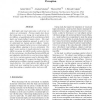Free Online Productivity Tools
i2Speak
i2Symbol
i2OCR
iTex2Img
iWeb2Print
iWeb2Shot
i2Type
iPdf2Split
iPdf2Merge
i2Bopomofo
i2Arabic
i2Style
i2Image
i2PDF
iLatex2Rtf
Sci2ools
HAPTICS
2007
IEEE
2007
IEEE
A Behavioral Adaptation Approach to Identifying Visual Dependence of Haptic Perception
Both haptic and visual senses play a role in how we explore our environment. Previous studies have shown that vision plays a very strong role in perception of object stiffness, yet quantification of the contributions of both haptic and visual feedback remains elusive. This study uses a behavioral adaptation approach in order to better understand how humans perceive stiffness. Namely, subjects make targeted reaches across a virtual surface of varying stiffness, adapting to the new environment. The hand’s cursor position is visually distorted to seem more stiff for one group, less stiff for another, and no distortion for the control group. Area Reaching Deviation (ARD) and post-adaptation interface forces, used in previous studies, were the two outcome measures used to determine differences between groups. We compare the slopes of the postadaptation force-stiffness relations to quantify the effect of visual distortion. Our results indicate that making a stiff surface look more compli...
| Added | 02 Jun 2010 |
| Updated | 02 Jun 2010 |
| Type | Conference |
| Year | 2007 |
| Where | HAPTICS |
| Authors | James S. Sulzer, Arsalan Salamat, Vikram S. Chib, J. Edward Colgate |
Comments (0)

